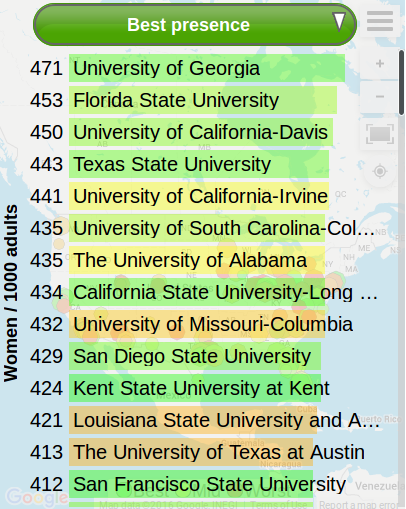If you are looking out for a place to study where romantic opportunities are above average, consider yourself lucky for finding this post. Take a couple of minutes to gather a bit of information here and act upon it. Your love life may benefit greatly.
One thing that can have a tremendous effect on your chances to meet, attract and maintain a lasting relationship with a fantastic girl or a fabulous guy during your student years is how the male to female ratio is among fellow scholars.
Quite a bit has been said and written about how the gender ratio at an educational facility affects whether there is likely to be predominantly a hookup culture or a culture leaning towards stable relationships on campus.
The saying is that when there are notably more girls than guys circling around, this will lead to more hookups and guys less willing to enter exclusive relationships. While when the gender ratio at campus is skewed male, those guys who can get a girl try to keep her around, thus leading to more stable relationships.
This factor is often overlooked when choosing where to study, partly because it has been difficult to get an overview over how the different places compare ratio-wise.
Singlesatlas to the rescue
Now this is a thing in the past. Recently in excess of 7500 American places of higher education have been added to the map containing data on how many guys versus girls there are in different age groups. As an added bonus there are estimates of their physical body types.
To use the map to find academic facilities with good ratios for you, specify your gender in the map below. Next select your desired age group using the age range slider. Leave the "Focus group" selector at "Everyone". Consider adjusting the height and BMI ranges. The map will be updated interactively. Zoom and pan around to concentrate on your regions of interest. Look at the "Best ratio places"-list to see places ordered by how many of the opposite gender there are compared to people of your own gender. Click a marker to get more information about a specific place.
Where should women study for the best chances of finding a boyfriend?
Assuming you are a straight woman, from a romantic point of view you will optimally want to find places with more male than female students. There it will be easier to find a steady boyfriend. If you did not care to check the ratios, you might for instance have chosen Boston University. In the 18-24 age group, there are about 6,900 men, and more than 11,000 women.
In other words, only 62 guys to fight over for every batch of 100 girls. Under such conditions, can you image how entitled, hard to keep those guys over there will be? This ratio might sound unheard of, but it isn't. In modern day society a lot more girls than guys take higher education. This has led to talks about an "educated man deficit" .
While you let that sink in, take a breath and consider Purdue University in Lafayette, Indiana. Here you will find more than 18,000 guys and about 13,500 girls in that same 18-24 group. Ratio-wise this means there will be instead 134 men fighting over those 100 girls. And it's not all about science and astronautics there. You will even find colleges for veterinary medicine and liberal arts.
Maybe you have decided that you only fancy guys standing six feet tall and above? Adjust the height range slider to see an estimate over how many you can expect to find, related to the amount of women around.
On the Atlas there is a list that as default shows "Best ratio places" - where places are ordered by their sex-ratio of interest. The top universities among the largest ones for girls looking for a good sex-ratio in the 18-24 age group are:
- 136 - Virginia Polytechnic Institute and State University
- 134 - Purdue University-Main Campus
- 125 - Iowa State University
- 123 - Arizona State University-Tempe
- 122 - North Carolina State University at Raleigh
The numbers show the number of male students enrolled per every 100 female students, in the 18-24 age group.
At which colleges and universities can men most easily meet women?
Now let's reverse things, and look at this from a guy's perspective. Due to the "educated man shortage" there are many places where you can date up. Florida has particularly many universities and colleges with more women than men attending.
An interesting feature of the Singlesatlas is its estimates for BMI-groups based on which US county institutions are located in. You know, how many falls into the "not overweight", "overweight" and "obese" categories.
In the article "Optimum body-mass index and maximum sexual attractiveness", a study described by Dr.Halls here, it is suggested that BMI is an important factor for how attractive young college men regard young women. It therefore makes sense to consider local BMI values as well as gender ratios when looking for a pleasant place to get a degree.
A significantly higher percentage of women have a BMI below the overweight limit of 25 in Manhattan counties than in Oktibbeha County, Mississippi. Let's consider the age group 18-29. The data says there are 93 women per 100 men at Baruch College in Manhattan. Similarly it is estimated that there are 92 women per 100 men at Mississippi State University. But in case you are a man primarily interested in non-overweight women you might want to adjust the BMI range selector down to 25 at maximum. Then you will find that there is an estimated 63 such women per 100 men (of all BMI ranges) at Baruch College, while the equivalent number is 42 at Mississippi State University.
Finding places with the highest proportion of dating prospects
An alternative to the "Best ratio places"-list is available if you select "Best presence". Here you will see estimates over how many students satisfy your selected criteria at each place, out of 1000 random students present. This is useful for finding places where you will meet a lot of your favorite kind of dating prospects. And fewer "disturbances" in the form of people not meeting your criteria.
The example in the table shows where the largest amount of female students are, aged 18-24, out of 1000 enrolled students at each place. The top place is University of Georgia, with 471 such women per 1000 students. There are smaller universities with a higher ratio of such students - the list is made from the ones with the most students.
Data sources
The student statistics used are from National Center for Education Statistics (NCES). The currently available numbers are from the 2013-14 enrollment year. While BMI estimates are based upon data presented in the US Health Map for 2011. Height estimates are based on a height distribution model for USA as a whole, meaning there are no local variations in the estimates.
Note that some of the institutions are spread across multiple campuses geographically not in the vicinity of each other.
Ratio figures typically do not change that much from year to year, so you can feel quite safe that the numbers you find will be not much different the next few years.
For a full list of data sources, check the Sources and Attributions page.
All of that data is within easy reach when using the Singlesatlas. I hope understanding it is self explanatory. If not, please complain, write, I am here to help.
A whole world to explore
The Singlesatlas has more to offer than ratio information for academic institutions. You can check out gender ratios for different ethnicities living in USA, like for instance Asians. Or see which ZIP-code areas have a high ratio of men with at least a Bachelor's Degree. Many countries are covered with local data. And for several of these you have the option to see ratios among only the people who are not married.
There is a Countries-view where mostly all nations can be compared. You can also filter out countries that are expensive to live in, have low democratic standards and more.
Now, if you find this interesting, please share your findings with your friends. So that all of you will study in an environment of romantic abundance, and not in competition with each other.

 By Singlesatlas, updated May 18th, 2016
By Singlesatlas, updated May 18th, 2016
